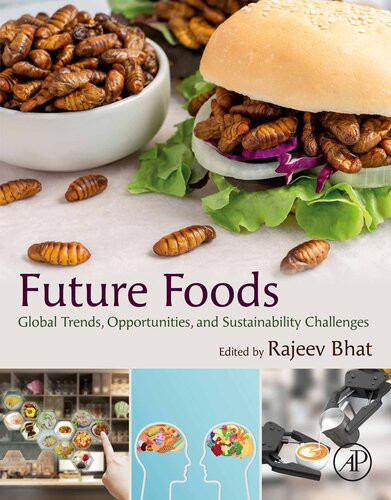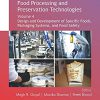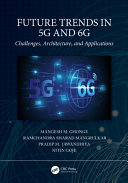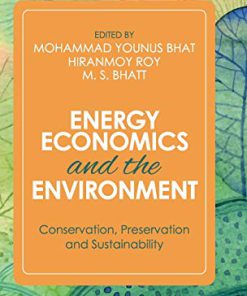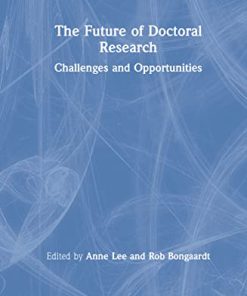Future Foods: Global Trends, Opportunities and Sustainability Challenges 1st Edition by Rajeev 9780323910026 0323910025
$50.00 Original price was: $50.00.$25.00Current price is: $25.00.
Future Foods: Global Trends, Opportunities and Sustainability Challenges 1st Edition Rajeev Bhat – Ebook Instant Download/Delivery ISBN(s): 9780323910026, 0323910025

Product details:
- ISBN 10: 0323910025
- ISBN 13:9780323910026
- Author: Rajeev
Future Foods
Global Trends, Opportunities, and Sustainability Challenges
- Provides practical solutions for overcoming recurring sustainability challenges along the entire agri-food supply chain
- Highlights potential industrial opportunities and supports circular economy concepts
- Proposes novel concepts to address various sustainability challenges that can affect and have an impact on the future generations
Table contents:
Chapter 1: Emerging trends and sustainability challenges in the global agri-food sector
Abstract
1: Introduction
2: Sector-based sustainability challenges
3: Innovative technologies for agri-food industry
4: New food ingredients and designer foods
5: Underutilized resources
6: Food security, self-sufficiency and climate change impacts
7: Traditional food sector
8: Consumers and the food industry
9: Conclusion, opportunities and future challenges
References
Chapter 2: Approaches for sustainable food production and consumption systems
Abstract
Acknowledgments
1: Introduction
2: First challenge: Sustainable development of food systems
3: Second challenge: Reduction of food loss and waste
4: Third challenge: Global healthy diets
5: Conclusion: Opportunities and future challenges
References
Chapter 3: Smart and sustainable food: What is ahead?
Abstract
Acknowledgments
1: Introduction: The socio-ecological problems of the agri-food sector
2: The role of digital technologies
3: Impacts and solutions
4: Conclusion, opportunities, and future challenges
References
Chapter 4: Climate change and future of agri-food production
Abstract
1: Introduction
2: World population trends and pressure on agricultural production
3: Climate change: An overview
4: Trends, projections and impacts of climate change on crop production
5: Extreme weather events and their impacts on agriculture
6: Impact of sea-level rise on coastal agriculture
7: Climate change and invasive alien plants: Distribution, changes, and impacts on agriculture
8: Pests and pathogens under a changing climate and their impacts on food production
9: Neglected, underutilized and wild edible plants: Mainstreaming into food systems
10: Climate change impacts—Adaptation and mitigation for food security
11: Conclusion, opportunities and future challenges
References
Chapter 5: Future grain crops
Abstract
Graphical abstract
Acknowledgments
1: Introduction
2: Brief overview of the grains that feed the world
3: Pseudocereals
4: Nutritional and polyphenol composition
5: Pests and diseases in cereal grains
6: Technology application and agriculture
7: Conclusion, opportunities and future challenges
References
Chapter 6: Expectations for household food security in the coming decades: A global scenario
Abstract
1: Introduction
2: Global food crises: A snapshot
3: Food production
4: Future challenges for food security
5: Sustainable food systems: A means to improve food security
6: Conclusion, opportunities and future challenges
References
Chapter 7: Underutilized fruits: Challenges and constraints for domestication
Abstract
1: Introduction
2: Underutilized fruits: Unlocking pathway to sustainable diets
3: Potential use of underutilized fruits
4: Domestication of UFs: Principle strategies for tree domestication
5: Challenges and constraints for domestication
6: Proposed domestication strategies
7: Conclusion, opportunities and future prospects
References
Further reading
Chapter 8: Mainstreaming underutilized legumes for providing nutritional security
Abstract
1: Introduction
2: Orphan crops: Need for mainstreaming
3: Diverse attributes of legumes
4: A brief note on some of the underutilized legumes
5: Current status and prospects of underutilized legumes
6: Opportunities and future challenges
References
Chapter 9: Designer food and feeds from underutilized fruits and vegetables
Abstract
1: Introduction
2: Underutilized fruits
3: Underutilized vegetables, cereals, and pulses
4: Health benefits of designer foods with underutilized fruits and vegetables
5: Conclusion, opportunities, and future challenges
References
Chapter 10: Seaweeds and microalgal biomass: The future of food and nutraceuticals
Abstract
Acknowledgment
1: Introduction
2: Nutritional attributes of algae
3: Use of algae or algal derived ingredients in food
4: Future trends using algae as food
5: Conclusion, opportunities, and future challenges
References
Chapter 11: Current trends and next generation of future edible oils
Abstract
1: Introduction
2: New sources of the edible oil for the future
3: Perspectives and challenges
4. Conclusion, opportunities, and future challenges
References
Chapter 12: Plant-based milk products
Abstract
1: Introduction
2: Market scenario
3: Plant-based milk
4: Powdered milk
5: Cheese
6: Ice cream
7: Fermented plant-based milk and derivatives
8: Fermented beverage products
9: Traditional fermented beverage products
10: Microbiological contamination in vegetable extracts
11: Conclusion, opportunities, and future challenges
References
Chapter 13: Nutraceuticals and functional beverages: Focus on Prebiotics and Probiotics active beverages
Abstract
1: Introduction
2: Nutraceuticals
3: Functional beverages
4: Focus on probiotics, prebiotics, and synbiotics beverages
5: Conclusion, opportunities, and future challenges
References
Chapter 14: Future innovations in alcohol-based beverage industry
Abstract
1: Introduction
2: The contribution of honey in traditional and novel alcoholic beverages
3: In vitro antioxidant activity of fermented prickly pear juice and pulp with Saccharomyces cerevisiae (ex r.f. bayanus) yeast strain in combination with sugar and blossom honey
4: Conclusion, opportunities, and future challenges
References
Chapter 15: Future food proteins—Trends and perspectives
Abstract
1: Introduction
2: Promising protein sources
3: Protein recovery
4: Design of innovative protein systems
5: Conclusion, opportunities, and future challenges
References
Chapter 16: Mycoprotein: A futuristic portrayal
Abstract
1: Introduction
2: Origins & production
3: A futuristic portrayal
4: Human health
5: Planetary health
6: Conclusion, opportunities, and future challenges
References
Chapter 17: Edible vaccines: Current scenario and future prospects
Abstract
1: Introduction
2: A brief history on the development of edible vaccines
3: Advantages of edible vaccines over that of conventional vaccines
4: Limitations
5: Mechanism of action
6: The production of edible vaccines
7: Crops for production of edible vaccines
8: Development of an edible vaccine against COVID-19
9: The second-generation edible vaccines
10: Conclusion, opportunities, and future challenges
References
Chapter 18: Sustainability challenges in edible bird’s nest: Full exploitation and health benefit
Abstract
Acknowledgments
1: Introduction
2: Edible bird’s nest
3: Sustainability challenges in E-BN valorization
4: Conclusion, opportunities and future challenges
References
Chapter 19: The future of cultured meat between sustainability expectations and socio-economic challenges
Abstract
1: Introduction
2: Positive externalities of cultured meat
3: The potential impact of cultured meat on conventional meat supply chains
4: Consumer perception of cultured meat
5: The naming, terminology, and regulatory framework for cultured meat
6: Conclusion, opportunities, and future challenges
References
Chapter 20: Meat alternatives
Abstract
1: Introduction
2: Sustainable meat-free protein alternatives
3: Meat-free protein alternatives
4: Challenges of using plants as a meat substitute
5: Conclusion, opportunities, and future challenges
References
Chapter 21: Innovations in food packaging—Sustainability challenges and future scenarios
Abstract
1: Introduction
2: Sustainability challenges
3: Future scenarios
4: Conclusion, opportunities and future challenges
References
Chapter 22: The use of emerging dehydration technologies in developing sustainable food supply chain
Abstract
1: Introduction to sustainability in food supply chain
2: Calculation of GHG emissions and energy consumption
3: Dehydration technologies used in food supply chain
4: The effect of emerging dehydration technologies on food quality
5: The effect of emerging dehydration technologies on GHG emissions
6: The effect of emerging dehydration technologies on cost savings
7: Conclusions, opportunities, and future challenges
References
Chapter 23: GASTRONOMY: A novel social representation of foods through consumers’ language
Abstract
1: Introduction
2: What is gastronomy?
3: Social representations: An interesting approach to understanding foods and their conception
4: Theoretical and methodological implications of social representations: The projective technique of word association (WA), the Central Core Theory, and the Cognitive Salience Index (CSI)
5: Towards a novel social representation of gastronomy based on the language of consumers in two Latin American countries
6: Social representations of gastronomy: Future trends, opportunities, and sustainability challenges
7: Conclusion, opportunities, and future challenges
References
Chapter 24: Neurobiology of food addiction
Abstract
Acknowledgments
1: Introduction
2: Neurophysiology of food consumption and energy production
3: Drug and food addictions and neural circuit pathways
4: Evidence from animal studies
5: Conclusion: Opportunities and future challenges
References
Chapter 25: Human population genomics approach in food metabolism
Abstract
1: Introduction
2: Human genetic variation and its significance
3: Population genetics of dietary selection and food metabolism
4: Significance and complications of a gene-diet interaction in food metabolism
5: Budding field of nutritional genomics
6: Conclusion, opportunities, and future challenges
References
Chapter 26: Space food on celestial bodies and on the way there
Abstract
1: Introduction
2: Space farming
3: Microgravity science
4: Commercializing space-based research of plants
5: Conclusion, opportunities, and future challenges
References
Chapter 27: Designer foods as an effective approach to enhance disease preventative properties of food through its health functionalities
Abstract
Acknowledgments
1: Introduction
2: Designer foods from plant sources
3: Designer foods from animal sources
4: Designer foods from insect source
5: Designer foods from bacteria source
6: Designer foods development
7: Conclusion, opportunities and future challenges
References
Chapter 28: What foods might kids eat in the future? Using plant-based games to educate about sustainable healthy diet
Abstract
1: Introduction
2: Playing with coffee waste to be healthy and altruistic in the future: The fungi pack case study
3: Case study
4: Results of the case study
5: Conclusion, opportunities, and future challenges
Appendix
References
Chapter 29: Restoring the values of traditional foods
Abstract
1: Introduction
2: Institutional resilience
3: The Totonac ethnic group: A case study
4: Indigenous food systems
5: Traditional foods and sustainability challenges
6: Challenges of developing a food agenda for future generations
7: Conclusions, opportunities, and future challenges
References
Chapter 30: Between conventionalization and emancipation: Present and future paths for organic food market organization
Abstract
Acknowledgments
1: Introduction
2: The current debate about organic food
3: Recognizing the future of organics in two empirical cases
4: What does our theoretical and empirical analysis reveal about the future of organic food markets?
5: Conclusions, opportunities, and future challenges
References
Chapter 31: Agricultural productivity and food supply to meet increased demands
Abstract
1: Introduction
2: History of food production
3: Agricultural food productivity
4: Demand for foods (agricultural products)
5: Agricultural technologies to increase food production
6: Conclusions, opportunities, and future challenges
References
Chapter 32: High-productive agricultural technologies to fulfill future food demands: Hydroponics, aquaponics, and precision/smart agriculture
Abstract
1: Introduction
2: Hydroponic technology for increasing food production
3: Use of the aquaponic system to integrate plant and fish culture
4: Precision/smart agricultural technologies for increasing food production
5: Conclusions, opportunities, and future challenges
References
Chapter 33: Food waste and by-product valorization as an integrated approach with zero waste: Future challenges
Abstract
Acknowledgments
1: Introduction
2: Food wastes and food by-products
3: Valorization strategies for wastes and by-products generated from the food industry toward a circular bioeconomy
4: Legislation and regulations
5: Conclusions, opportunities, and future challenges
References
Chapter 34: Food fraud countermeasures and consumers: A future agenda
Abstract
1: Introduction
2: Assessment
3: Blockchain and digitization of food chain
4: Deterrence—Food safety (and integrity) culture
5: Prevention
6: Detection
7: Conclusion, opportunities, and future challenges
References
Chapter 35: ICT applications for the food industry
Abstract
1: Introduction
2: Robots in food industries
3: Industry 4.0 evolution in the food-processing sector
4: Components of information and communication technologies
5: Data communication devices and applications in the food industry
6: The IoT in the food industry
7: Summary of key applications of ICT technologies in sustainable food systems
8: Conclusion: Opportunities and future challenges
References
Chapter 36: 3D food printing: Genesis, trends and prospects
Abstract
1: Introduction
2: Printable food product families
3: Main utility of 3DFP: Personalized nutrition
4: Main questions around 3DFP
5: Emerging trends and long-term prospects
6: Conclusion, opportunities, and future challenges
References
Chapter 37: Non-destructive methods for detection of food quality
Abstract
Acknowledgment
1: Introduction
2: Non-destructive methods
3: Conclusion, opportunities, and future challenges
References
Chapter 38: Authentication of wine and other alcohol-based beverages—Future global scenario
Abstract
1: Introduction
2: Wine authentication
3: Authentication of distilled alcoholic beverages
4: Authentication of other fermented beverages
5: Future scenario
6: Conclusion, opportunities and future challenges
References
Chapter 39: Food biotechnology: Innovations and challenges
Abstract
1: Introduction
2: Impact of biotechnology in the agri-food sector
3: Innovation and challenges for food applications
4: Innovation of the future
5: Conclusion, opportunities, and future challenges
References
Chapter 40: Nanoscience and nanotechnology advances in food industry
Abstract
Acknowledgment
1: Introduction
2: Nanotechnology for the food packaging industry
3: Intelligent and active packaging
4: Metallic nanoparticles
5: Biological synthesis of nanoparticles
6: Conclusion, opportunities and future challenges
References
Chapter 41: Food quality monitoring through bioinformatics and big data
Abstract
1: Introduction
2: Conventional analytical-based food quality monitoring tools and their challenges
3: Bioinformatics in monitoring food quality
4: Big data in monitoring food quality
5: Conclusion, opportunities and future challenges
References
Index
People also search:
future foods: global trends, opportunities
future trends in the world
future trends examples
future trends in nutrition
food trends of the future
You may also like…
Engineering - Telecommunications
Future Trends in 5G and 6G: Challenges, Architecture, and Applications 1st Edition Ghonge
Business & Economics - Others
Signals: The 27 Trends Defining the Future of the Global Economy 1st Edition Jeff Desjardins
Education Studies & Teaching - Bilingual & Multicultural Education
Politics & Philosophy - Social Sciences
Business & Economics - Personal Finance
Uncategorized
Medicine - Oncology
Cancer Diagnostics and Therapeutics Current Trends Challenges and Future Perspectives S.K. Basu

